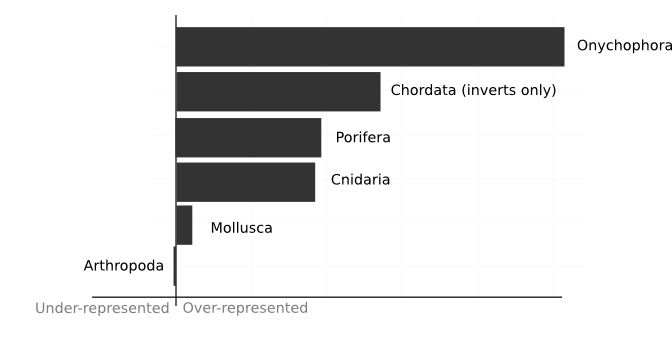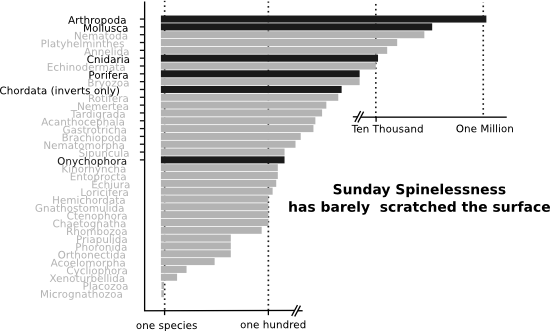Sunday, October 24, 2010
A year of Sundays
It's been as close to a year as we are going to get since I posted the first Sunday Spinelessness. I wasn't quite sure that I would be able to keep up the weekly schedule when I started the series, but I've managed it minus breaks over Christmas and for my trip to the USA and Canada (there are occasionally times I try and stay away from computers). Part of the reason I called the first post Sunday Spinelessness was to guilt myself into writing at least one post a week, and as I've moved more and more into writing up my own research over this year these Sunday posts have been a really welcome break (and a good writing excercise at that). As you can tell, I've been in a slightly reflective mood thinking about this post, and when I get reflective I like to look at some data.
Like, how representative has these Sunday Spinelessness posts been? The phylum is the highest level of classification within a taxonomic kingdom, animals placed in different phyla represent fundamentally different designs for life and in the order of 600 million years of independent evolution. In day to day life we probably only aware of a few phyla, vertebrates make up the bulk of Chordata, insects crustaceans and spiders are all arthopods, snails and clams are molluscs and earth worms are annelids. Depending on who you ask, and when you ask them, there are 36 animal phyla ( the confusion mainly caused by strange animals with almost no useful characters for taxonomists to look at). So, how may have been represented here:
Click above to see a larger version, note the x-axis is on a log-scale and number of species is number currently described
I knew I mainly wrote about arthropds, but I've only written about about 6 of the 36 animal phyla? It looks like I have a lot more work to do. Some of the phyla I've so far neglected are fascinating creatures;there are probably hundreds of thousands more nematode species that currently described and one of them is an important model organism in cell biology, echinoderms share some fundamental aspects of their development with vertebarates but end up being radically different (with five-fold symetry rather than our "down the middle" two fold symmetry), brachiapods look a lot like bivalve molluscs (clams and oysters and the like) and were once many times more common than their look-alikes but are few and far between now, tardigrades might just be the coolest animals on (or indeed off) earth. Even more excitingly for me, there are phyla in there I know almost nothing about. Apparently, Rhombozoa means "lozenge animal" and this phylum is restricted to parsitising the renal gland of squids and octopusses, and phoronids are worm-shaped but have a gut that loops back towards the mouth, and so on it goes.
Ok, so I haven't really touched on the true diversity of life without a backbone yet. What about the numbers, about three quarters of these posts have been about arthropods which represents the avaliability of photographic subjects in my bakcyard but must over-represent these creatures as a whole? I came up with an index to display how representative a phylum's post count is here. You should probably just skip to the graph which is pretty self-explanatory, but if you wanted to know the formula is
representation = log ( (speciesphylum / speciestotal) / (postsphylum / poststotal) )
And the graph:

So, arthropod species actually make up even more of the biological world than they do posts here (and just one post about peripatus is enough to make Onychophora the most overrepresented group of all). I also have to feel a little shame as a dilettante malacologist that I haven't spoken nearly enough about the molluscs thus far. There is another post on the way with those leaf veined slugs which should help tip the balance though.
Well that's about it. A quick look at the data tells me I'll have no trouble finding subjects for future Sunday Spinelessness posts and I can be a little less concerned about featuring so many arthropods!
Labels: blog blogging, sci-blogs, sunday spinelessness
3 Comments:
There is such a thing as a bad winner you know...
Ted,
Definately! I think there have only been two beetles, and one of them was from my trip to Canada. There are tonnes of beetles in New Zealand (about the same as elsewhere, ~40% of described species) but most of ones I see regularly are too small or too manic (staphylinids just never stat still!) for me to photograph even passingly well so they seldom feature.





